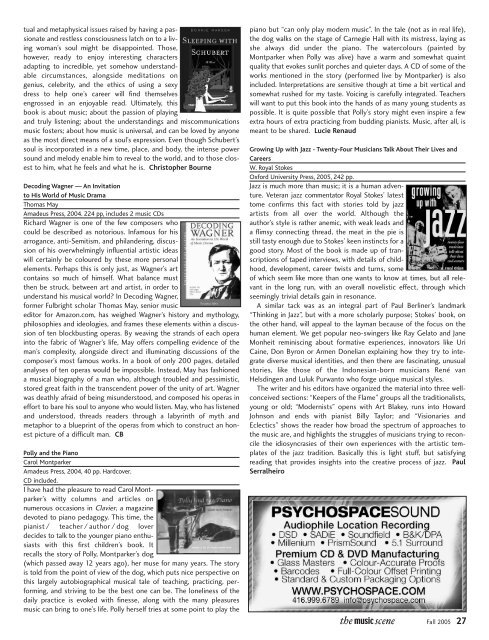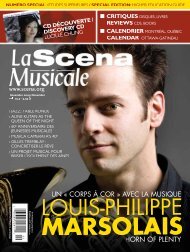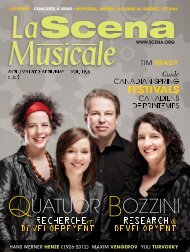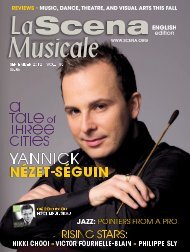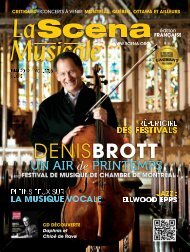Download - La Scena Musicale
Download - La Scena Musicale
Download - La Scena Musicale
Create successful ePaper yourself
Turn your PDF publications into a flip-book with our unique Google optimized e-Paper software.
tual and metaphysical issues raised by having a passionate<br />
and restless consciousness latch on to a living<br />
woman’s soul might be disappointed. Those,<br />
however, ready to enjoy interesting characters<br />
adapting to incredible, yet somehow understandable<br />
circumstances, alongside meditations on<br />
genius, celebrity, and the ethics of using a sexy<br />
dress to help one’s career will find themselves<br />
engrossed in an enjoyable read. Ultimately, this<br />
book is about music; about the passion of playing<br />
and truly listening; about the understandings and miscommunications<br />
music fosters; about how music is universal, and can be loved by anyone<br />
as the most direct means of a soul’s expression. Even though Schubert’s<br />
soul is incorporated in a new time, place, and body, the intense power<br />
sound and melody enable him to reveal to the world, and to those closest<br />
to him, what he feels and what he is. Christopher Bourne<br />
Decoding Wagner — An Invitation<br />
to His World of Music Drama<br />
Thomas May<br />
Amadeus Press, 2004. 224 pp, includes 2 music CDs<br />
Richard Wagner is one of the few composers who<br />
could be described as notorious. Infamous for his<br />
arrogance, anti-Semitism, and philandering, discussion<br />
of his overwhelmingly influential artistic ideas<br />
will certainly be coloured by these more personal<br />
elements. Perhaps this is only just, as Wagner’s art<br />
contains so much of himself. What balance must<br />
then be struck, between art and artist, in order to<br />
understand his musical world? In Decoding Wagner,<br />
former Fulbright scholar Thomas May, senior music<br />
editor for Amazon.com, has weighed Wagner’s history and mythology,<br />
philosophies and ideologies, and frames these elements within a discussion<br />
of ten blockbusting operas. By weaving the strands of each opera<br />
into the fabric of Wagner’s life, May offers compelling evidence of the<br />
man’s complexity, alongside direct and illuminating discussions of the<br />
composer’s most famous works. In a book of only 200 pages, detailed<br />
analyses of ten operas would be impossible. Instead, May has fashioned<br />
a musical biography of a man who, although troubled and pessimistic,<br />
stored great faith in the transcendent power of the unity of art. Wagner<br />
was deathly afraid of being misunderstood, and composed his operas in<br />
effort to bare his soul to anyone who would listen. May, who has listened<br />
and understood, threads readers through a labyrinth of myth and<br />
metaphor to a blueprint of the operas from which to construct an honest<br />
picture of a difficult man. CB<br />
Polly and the Piano<br />
Carol Montparker<br />
Amadeus Press, 2004, 40 pp. Hardcover.<br />
CD included.<br />
I have had the pleasure to read Carol Montparker’s<br />
witty columns and articles on<br />
numerous occasions in Clavier, a magazine<br />
devoted to piano pedagogy. This time, the<br />
pianist / teacher / author / dog lover<br />
decides to talk to the younger piano enthusiasts<br />
with this first children’s book. It<br />
recalls the story of Polly, Montparker’s dog<br />
(which passed away 12 years ago), her muse for many years. The story<br />
is told from the point of view of the dog, which puts nice perspective on<br />
this largely autobiographical musical tale of teaching, practicing, performing,<br />
and striving to be the best one can be. The loneliness of the<br />
daily practice is evoked with finesse, along with the many pleasures<br />
music can bring to one’s life. Polly herself tries at some point to play the<br />
piano but “can only play modern music”. In the tale (not as in real life),<br />
the dog walks on the stage of Carnegie Hall with its mistress, laying as<br />
she always did under the piano. The watercolours (painted by<br />
Montparker when Polly was alive) have a warm and somewhat quaint<br />
quality that evokes sunlit porches and quieter days. A CD of some of the<br />
works mentioned in the story (performed live by Montparker) is also<br />
included. Interpretations are sensitive though at time a bit vertical and<br />
somewhat rushed for my taste. Voicing is carefully integrated. Teachers<br />
will want to put this book into the hands of as many young students as<br />
possible. It is quite possible that Polly’s story might even inspire a few<br />
extra hours of extra practicing from budding pianists. Music, after all, is<br />
meant to be shared. Lucie Renaud<br />
Growing Up with Jazz - Twenty-Four Musicians Talk About Their Lives and<br />
Careers<br />
W. Royal Stokes<br />
Oxford University Press, 2005, 242 pp.<br />
Jazz is much more than music; it is a human adventure.<br />
Veteran jazz commentator Royal Stokes’ latest<br />
tome confirms this fact with stories told by jazz<br />
artists from all over the world. Although the<br />
author’s style is rather anemic, with weak leads and<br />
a flimsy connecting thread, the meat in the pie is<br />
still tasty enough due to Stokes’ keen instincts for a<br />
good story. Most of the book is made up of transcriptions<br />
of taped interviews, with details of childhood,<br />
development, career twists and turns, some<br />
of which seem like more than one wants to know at times, but all relevant<br />
in the long run, with an overall novelistic effect, through which<br />
seemingly trivial details gain in resonance.<br />
A similar tack was as an integral part of Paul Berliner’s landmark<br />
“Thinking in Jazz”, but with a more scholarly purpose; Stokes’ book, on<br />
the other hand, will appeal to the layman because of the focus on the<br />
human element. We get popular neo-swingers like Ray Gelato and Jane<br />
Monheit reminiscing about formative experiences, innovators like Uri<br />
Caine, Don Byron or Armen Donelian explaining how they try to integrate<br />
diverse musical identities, and then there are fascinating, unusual<br />
stories, like those of the Indonesian-born musicians René van<br />
Helsdingen and Luluk Purwanto who forge unique musical styles.<br />
The writer and his editors have organized the material into three wellconceived<br />
sections: “Keepers of the Flame” groups all the traditionalists,<br />
young or old; “Modernists” opens with Art Blakey, runs into Howard<br />
Johnson and ends with pianist Billy Taylor; and “Visionaries and<br />
Eclectics” shows the reader how broad the spectrum of approaches to<br />
the music are, and highlights the struggles of musicians trying to reconcile<br />
the idiosyncrasies of their own experiences with the artistic templates<br />
of the jazz tradition. Basically this is light stuff, but satisfying<br />
reading that provides insights into the creative process of jazz. Paul<br />
Serralheiro<br />
Fall 2005 27


